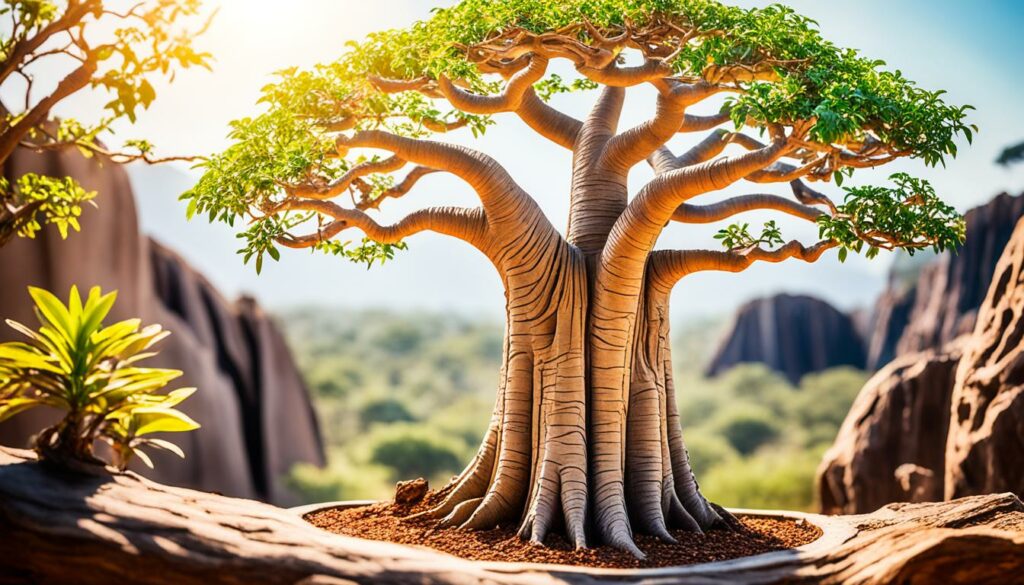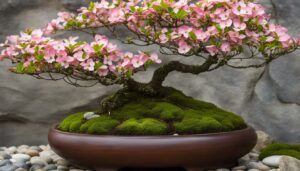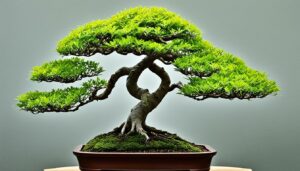Explore the world of bonsai trees with the captivating Baobab species. These bonsai trees are unique, not just because of their beauty but also because they represent longevity and strength. If you’re looking to learn about a tree with a rich history and cultural symbolism, then you’ve come to the right place.
The Baobab bonsai tree species is one of the most popular African bonsais and for a good reason. Its distinctive features, like the swollen trunk and the rectangular-shaped crown, make it uniquely different from other bonsais. The Baobab bonsai tree is a symbol of strength, resilience, and endurance – a perfect representation of the vast African savannas where it originated.
Key Takeaways:
- The Baobab bonsai tree species symbolizes strength, resilience, and endurance.
- The swollen trunk and rectangular-shaped crown are the distinctive features of the Baobab bonsai.
- It is an African bonsai that has a rich cultural history and symbolism.
- The Baobab bonsai requires specific techniques and considerations for cultivation and growth.
- Through a Baobab bonsai, you can bring a piece of the African savanna into your space.
Understanding Baobab Bonsai: A Piece of Africa
Explore the captivating history of African bonsai with the unique Baobab bonsai species. Originally from the African savannas, this stunning bonsai has become a cherished representation of African culture.
The Baobab bonsai tree boasts distinctive characteristics that set it apart from other bonsai tree species, making it a unique bonsai variety. The Baobab bonsai has a bulbous trunk design that allows it to store large amounts of water, which is necessary for its survival in arid conditions. Additionally, it produces velvety textured leaves during the wet season, with tiny white flowers that bloom at night.
Embrace the wholly unique aesthetic of the Baobab bonsai, a beautiful and striking type of bonsai that brings African culture into your home or garden, while promoting the cultural importance of preserving this incredible species.
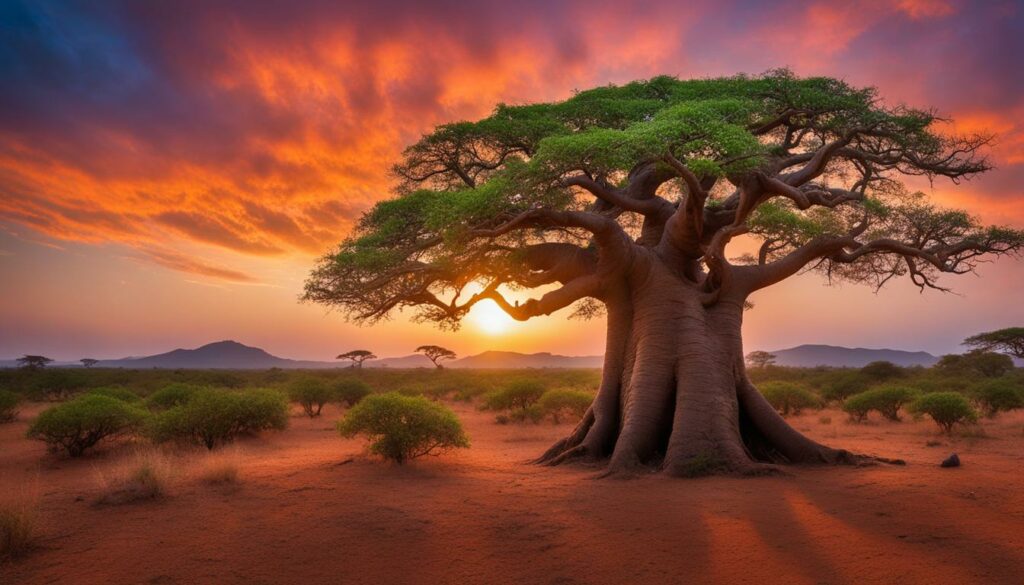
Cultivating Baobab Bonsai: A Labor of Love
Now that you’ve learned about the captivating world of Baobab Bonsai in the previous sections, it’s time to delve into cultivating this unique type of bonsai. It takes patience, skill, and a lot of love to grow a healthy and stunning Baobab bonsai, but the results are worth it.
First and foremost, you need to make sure that you have chosen the right soil and pot for your bonsai. Baobab bonsais thrive in well-draining soil, so ensure that the soil you use isn’t too firm or dense. As for the pot, it should be deep and have proper drainage holes to allow water to drain out entirely. An ideal pot is wider than the trunk diameter of the tree, allowing for the roots to spread and grow.
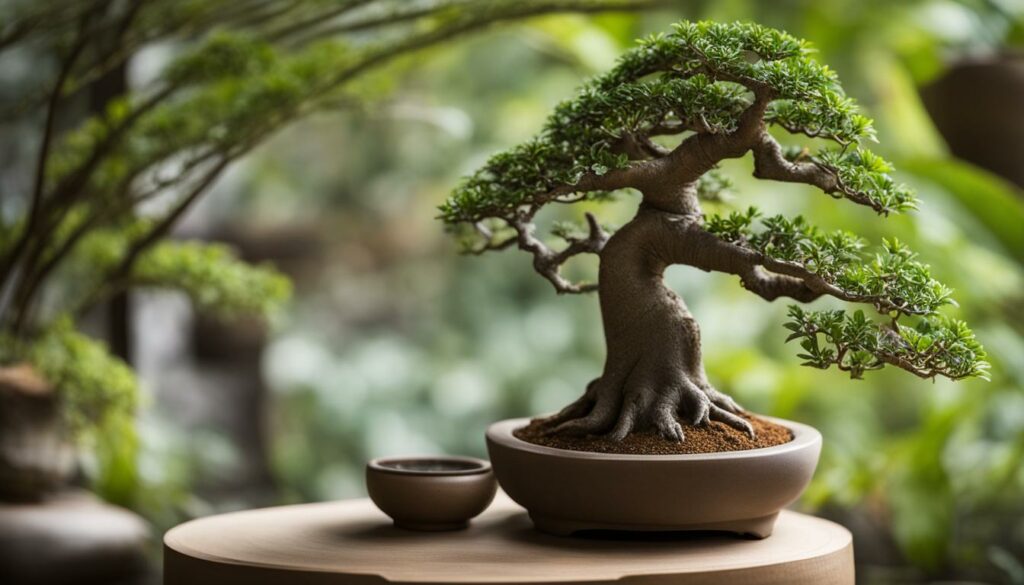
Next, it’s time to start pruning your Baobab bonsai to give it that iconic, artistic look. When pruning, do not cut into the old wood, as it will not regenerate. Always prune to promote new growth.
Sunlight is also crucial to the growth of your Baobab bonsai. These trees need full sun for several hours each day, but be sure to avoid putting them in the intense afternoon sun, which can lead to issues. An ideal location would be next to a window with a southern exposure.
Caring for your Baobab bonsai means providing it with sufficient water while allowing the soil to dry slightly between watering to avoid overwatering. Moreover, use a balanced liquid fertilizer for the best results.
Overall, growing a Baobab bonsai tree is a labor of love, but it pays off in the end. With the right pot, soil, pruning, and care, you can grow a beautiful, long-lasting symbol of Africa in your home or garden.
The Symbolism of Baobab Bonsai: Strength and Longevity
As a symbol of strength and resilience, owning a Baobab bonsai can bring a sense of serenity and inspiration to any space. This unique tree species has captivated various African communities for centuries, imbuing the bonsai with significant cultural significance.
Endurance and Longevity
The Baobab bonsai is a representation of endurance and longevity in African culture, as its thick trunk and vast root system allow it to survive in the harshest conditions. It symbolizes the ability to withstand adversity and emerge stronger, reminding us of the importance of resilience in times of hardship.
Stories and Legends
Throughout history, Baobab trees have been the subject of legends and stories in Africa, with some cultures believing that these trees were once upright but were forced to grow upside down after angering the gods. Others believed that tribal spirits resided in the trees, bringing good luck to those who honored them. These stories add to the mystique and cultural significance of the Baobab bonsai, making it a treasured addition to any collection.
“The Baobab bonsai is a representation of endurance and longevity in African culture, as its thick trunk and vast root system allow it to survive in the harshest conditions.”
Cultural Significance
The Baobab bonsai’s cultural significance extends beyond its symbolic meanings, as it is also a cherished representation of African heritage. Owning a Baobab bonsai can be a reminder of the beauty and diversity of African culture, making it an ideal addition to any space that values cultural awareness and appreciation.
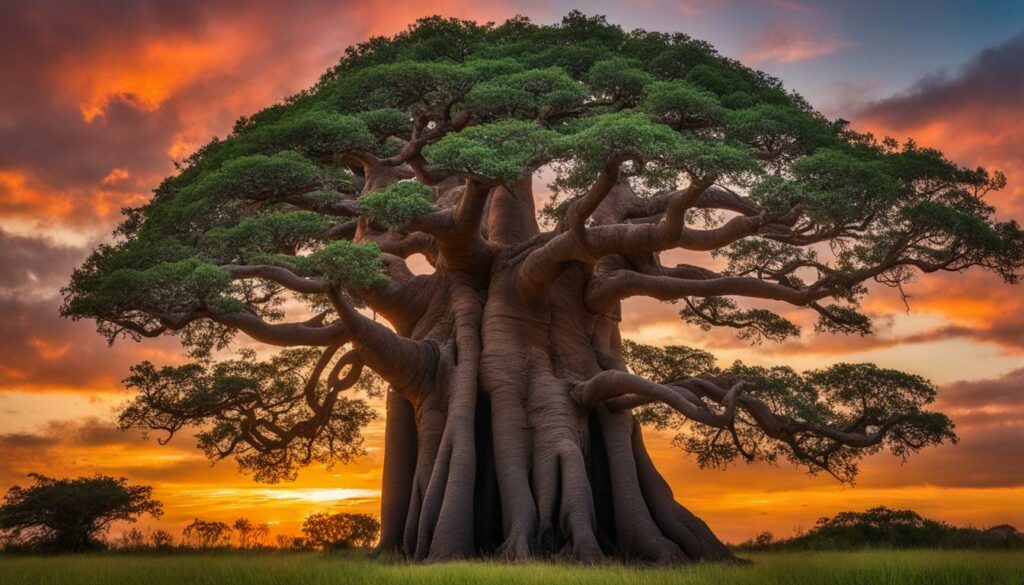
Overall, the Baobab bonsai is a truly symbolic and unique specimen that captures the essence of strength, resilience, and endurance. Owning a Baobab bonsai means embracing the beauty and significance of African culture, bringing a piece of the continent into your own space.
The Baobab Bonsai: A Captivating Addition to Your Bonsai Collection
By cultivating a Baobab bonsai, you can bring a piece of the African savanna into your space and symbolize strength, resilience, and longevity. The unique characteristics and symbolic value of the Baobab bonsai make it an extraordinary choice for bonsai enthusiasts seeking a one-of-a-kind bonsai experience.
You don’t have to travel to Africa to experience the allure of the Baobab bonsai. With proper care and maintenance, you can enjoy the beauty and cultural significance of this remarkable tree species in your own home or garden.
As with any bonsai, growing a Baobab bonsai requires patience, dedication, and a labor of love. Through careful pruning and attention to detail, you can maintain its iconic shape and appearance, ensuring it remains a cherished addition to your bonsai collection for years to come.
Whether you’re fascinated by its origins and history, or you simply appreciate its aesthetic beauty, the Baobab bonsai is a captivating addition to any collection. Its enduring symbolism as a representation of endurance, resilience, and longevity adds a sense of serenity and inspiration to any space.
In conclusion, growing a Baobab bonsai is an excellent way to enhance your bonsai collection and embrace the natural beauty and cultural significance of this remarkable tree species. By cultivating your own Baobab bonsai, you add a piece of Africa to your life, and enjoy the satisfaction and rewards of nurturing a living work of art.
FAQ
What is a Baobab bonsai?
A Baobab bonsai is a miniature version of the iconic Baobab tree, cultivated to resemble its natural form in a pot. It is a unique and captivating bonsai species that represents strength and longevity.
How is a Baobab bonsai different from other bonsai tree species?
Baobab bonsai stands out from other species due to its distinctive features and symbolism. It is known for its massive trunk and thick branches, which provide a sense of endurance and resilience. Additionally, Baobab bonsai has a unique connection to African culture, making it a cherished symbol of the continent.
How do I grow and care for a Baobab bonsai?
Growing and caring for a Baobab bonsai requires specific techniques and considerations. It is important to provide adequate sunlight, water, and well-draining soil. Pruning is also necessary to maintain its iconic shape. Regular fertilization and protection from extreme temperatures are crucial for the healthy growth of your Baobab bonsai.
What is the symbolism behind Baobab bonsai?
Baobab bonsai holds symbolic meaning as a representation of strength, resilience, and longevity. It embodies the spirit of the Baobab tree, which is known for its ability to withstand harsh conditions and live for thousands of years. Owning a Baobab bonsai can bring a sense of serenity and inspiration to any space.
Why should I consider owning a Baobab bonsai?
Owning a Baobab bonsai is a unique and captivating experience. Its distinctive characteristics and cultural significance make it a remarkable choice for bonsai enthusiasts. By cultivating a Baobab bonsai, you bring a piece of African heritage and natural beauty into your space, while also symbolizing strength and longevity.
